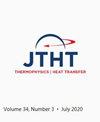Mars2020 Entry Shock Layer Thermochemical Kinetics Examined by Megahertz-Rate Laser Absorption Spectroscopy
IF 1.7
4区 工程技术
Q4 ENGINEERING, MECHANICAL
引用次数: 0
Abstract
A mid-infrared laser absorption diagnostic was deployed to examine the evolution of thermophysical properties across a simulated Mars2020 shock layer in the Electric Arc Shock Tube (EAST) facility at NASA Ames. Rapid laser tuning techniques using bias-tee circuitry enabled quantitative temperature and number density measurements of [Formula: see text] and CO with microsecond resolution over a shock velocity range of 1.30–3.75 km/s. Two interband cascade lasers were utilized at 4.17 and 4.19 μm to resolve rovibrational [Formula: see text] lines spanning across [Formula: see text] to [Formula: see text] in the asymmetric stretch fundamental bands. In test cases with enough energy to dissociate [Formula: see text], a quantum cascade laser scanned multiple transitions of the CO fundamental bands near [Formula: see text]. The results are compared to the Data Parallel Line Relaxation (DPLR) code and Lagrange shock tube analysis (LASTA) simulations of the shock layer. A numerical simulation of the compressible boundary layer is used to account for measurement sensitivities to this flow feature in the EAST facility. Temperature and species transients are compared to multiple chemical kinetic models. The laser absorption data presented in this work can be used to refine the models used to simulate the aerothermal environment encountered during Mars entry.用兆赫激光吸收光谱研究火星2020进入冲击层的热化学动力学
在NASA Ames的电弧激波管(EAST)设施中,部署了中红外激光吸收诊断来检查模拟Mars2020激波层的热物理性质演变。使用偏置电路的快速激光调谐技术可以在1.30-3.75 km/s的冲击速度范围内以微秒分辨率定量测量[公式:见文本]和CO的温度和数密度。在4.17 μm和4.19 μm波段使用两个带间级联激光器来解析非对称拉伸基带中跨越[公式:见文]到[公式:见文]的旋转振动[线]。在具有足够能量解离的测试用例中[公式:见文本],量子级联激光器扫描了CO基带附近的多个跃迁[公式:见文本]。结果与数据平行线松弛(DPLR)代码和拉格朗日激波管分析(LASTA)模拟的激波层进行了比较。可压缩边界层的数值模拟用于解释EAST设备中对这种流动特征的测量灵敏度。温度和物质瞬态与多种化学动力学模型进行了比较。这项工作中提供的激光吸收数据可用于改进用于模拟火星进入过程中遇到的空气热环境的模型。
本文章由计算机程序翻译,如有差异,请以英文原文为准。
求助全文
约1分钟内获得全文
求助全文
来源期刊

Journal of Thermophysics and Heat Transfer
工程技术-工程:机械
CiteScore
3.50
自引率
19.00%
发文量
95
审稿时长
3 months
期刊介绍:
This Journal is devoted to the advancement of the science and technology of thermophysics and heat transfer through the dissemination of original research papers disclosing new technical knowledge and exploratory developments and applications based on new knowledge. The Journal publishes qualified papers that deal with the properties and mechanisms involved in thermal energy transfer and storage in gases, liquids, and solids or combinations thereof. These studies include aerothermodynamics; conductive, convective, radiative, and multiphase modes of heat transfer; micro- and nano-scale heat transfer; nonintrusive diagnostics; numerical and experimental techniques; plasma excitation and flow interactions; thermal systems; and thermophysical properties. Papers that review recent research developments in any of the prior topics are also solicited.
 求助内容:
求助内容: 应助结果提醒方式:
应助结果提醒方式:


